Accessories
The Complete Firearm
Collecting firearms can be a pleasurable hobby. The
history, workings, and uses of firearms make for fascinating study, and as
show pieces, many firearms make for a handsome display. Sport and practical
shooting, however, make demands upon the firearm and the shooter which
require the employment of an integrated systems approach. It is a mistake
on the part of many beginning gun enthusiasts to think that being armed is
simply a matter of owning or carrying a firearm. There are some obvious accessories
such as holsters and belts, pouches and charging systems, but there is also
the matter of target acquisition, and storage and maintenance. All of these
facets of a complete system must come together for an individual to be able
to properly use and depend upon a firearm. The most important accessory is
in the matter of the training and mindset of the shooter; a subject which
will not be dealt with on this page.
Each of my firearms has a system built around it. In
the case of some of my small, hideout pistols, the system may be as simple
as a holster, and a couple of spare magazines with pouches. In the case of
some of my assault rifles, the system may get quite elaborate with ranging
devices, magazines and web gear, bipods, slings etc. The minimum system will
have a means of carrying the weapon, charging it, and maintaining it.
Carrying
A means to carry the weapon comfortably, and in some
cases unobtrusively, while keeping the hands free, is the first order of
business. In a rifle this means a carry strap, or a sling (not the same thing
by any means), for a pistol, this is generally taken to mean a holster. Holsters
come in many styles but their main function is to retain the weapon, and to
offer some degree of protection for it. There are other factors, such as
speed of presentation, and concealment which may enter into the design, but
there is generally a bit of compromise among the various functions. A traditional,
full flap holster offers excellent protection for the pistol in all weather,
but is very visible, and rather slow to draw from. A good concealment holster
offers little protection, and as they generally hold the piece rather close
to the wearer's body, exposure to sweat, and body oils makes increased cleaning
necessary. Deep concealment holsters (ankle, belly band and others) expose
the firearm to the corrosive effects of the wearers body, and are notoriously
slow to draw from.
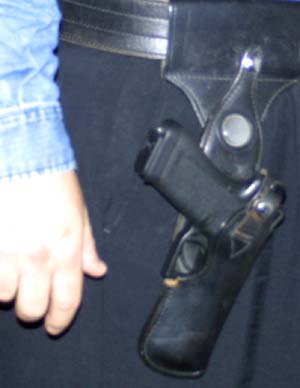 The Drop Holster
My personal favorite for full sized pistols worn openly,
is the drop holster. This is the holster style favored by most police, and
a variant of it is used in pistol competitions. The holster is stiff, and
most have a snap swivel so that they may be used while the wearer is seated,
as well as standing. The gun is held with the top open, and sits low on the
hip, almost at thigh level. The draw is very fast, and weapon retention is
good in the better designs, though mobility may be impaired somewhat. The
open top makes for poor protection, and the gun, though not exposed to the
wearer's body, is open to the elements. A drop holster will require a duty
belt, such as a Sam Brown or similar model, worn outside of all layers of
clothing, which can also hold magazine pouches, a flashlight, radios, etc.
like a scaled down version of Batman's utility belt. Each of my full sized
pistols has it's own integrated duty belt system. Notice how the drop holster
puts the pistol unobtrusively right at the wearer's hand, for an extremely
fast presentation. The earliest drop holsters were the old fashioned speed
rigs associated with the cowboy. In reality, these rigs did not come along
until the cowboy era was nearly ended, and did not enjoy great popularity
until the fast draw competitions of the 1950's.
The Drop Holster
My personal favorite for full sized pistols worn openly,
is the drop holster. This is the holster style favored by most police, and
a variant of it is used in pistol competitions. The holster is stiff, and
most have a snap swivel so that they may be used while the wearer is seated,
as well as standing. The gun is held with the top open, and sits low on the
hip, almost at thigh level. The draw is very fast, and weapon retention is
good in the better designs, though mobility may be impaired somewhat. The
open top makes for poor protection, and the gun, though not exposed to the
wearer's body, is open to the elements. A drop holster will require a duty
belt, such as a Sam Brown or similar model, worn outside of all layers of
clothing, which can also hold magazine pouches, a flashlight, radios, etc.
like a scaled down version of Batman's utility belt. Each of my full sized
pistols has it's own integrated duty belt system. Notice how the drop holster
puts the pistol unobtrusively right at the wearer's hand, for an extremely
fast presentation. The earliest drop holsters were the old fashioned speed
rigs associated with the cowboy. In reality, these rigs did not come along
until the cowboy era was nearly ended, and did not enjoy great popularity
until the fast draw competitions of the 1950's. |
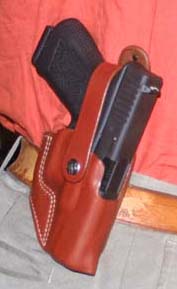 High Ride Hip Holster
I consider the best holster for every day use to be
the high ride hip holster. This holster attaches to the wearers trouser belt,
though a special heavy trouser belt (made by several holster makers) should
be used, particularly for a full sized pistol. Ideally, the holster will cant
forward a bit and should ride just behind the hip bone. When worn with a
jacket, or sport coat, this is a pretty good concealment holster, and the
draw can be quite fast with practice. This is also a very comfortable holster
to wear. There is an inside the pants variant of this holster, which is very
concealable indeed, and another variant which holds the pistol at a sharp
angle (almost horizontal) in the small of the back (called an S.O.B. holster).
The main problem with this class of holster is that it holds the pistol
so close to the wearer's body that it is constantly exposed to salt, humidity,
lint and dirt. The open top design of this holster magnifies the problem.
Of slightly less concern is that, particularly in the cooler months when much
outer clothing is worn, this holster can be somewhat slow to draw from, though
with practice the draw can still be fairly
High Ride Hip Holster
I consider the best holster for every day use to be
the high ride hip holster. This holster attaches to the wearers trouser belt,
though a special heavy trouser belt (made by several holster makers) should
be used, particularly for a full sized pistol. Ideally, the holster will cant
forward a bit and should ride just behind the hip bone. When worn with a
jacket, or sport coat, this is a pretty good concealment holster, and the
draw can be quite fast with practice. This is also a very comfortable holster
to wear. There is an inside the pants variant of this holster, which is very
concealable indeed, and another variant which holds the pistol at a sharp
angle (almost horizontal) in the small of the back (called an S.O.B. holster).
The main problem with this class of holster is that it holds the pistol
so close to the wearer's body that it is constantly exposed to salt, humidity,
lint and dirt. The open top design of this holster magnifies the problem.
Of slightly less concern is that, particularly in the cooler months when much
outer clothing is worn, this holster can be somewhat slow to draw from, though
with practice the draw can still be fairly fast. I have holsters of this type, along with magazine pouches, for most
of my full and medium frame pistols. The model shown to the left is a standard
model, but skelitanized, for easier concealment, though most models cover
more of the gun. Notice that, as cut down as the holster is, the trigger
guard is covered. As with nearly all holsters of this type, the pistol is
secured by a thumb break strap. Those new to concealed carry, along with
some people who should know better, have taken to wearing this type of holster
further forward, sometimes even around the belly. This is somewhat unsafe,
and makes the gun less concealable, and more likely to print on the user.
It can also actually make the presentation (the draw) slower.
fast. I have holsters of this type, along with magazine pouches, for most
of my full and medium frame pistols. The model shown to the left is a standard
model, but skelitanized, for easier concealment, though most models cover
more of the gun. Notice that, as cut down as the holster is, the trigger
guard is covered. As with nearly all holsters of this type, the pistol is
secured by a thumb break strap. Those new to concealed carry, along with
some people who should know better, have taken to wearing this type of holster
further forward, sometimes even around the belly. This is somewhat unsafe,
and makes the gun less concealable, and more likely to print on the user.
It can also actually make the presentation (the draw) slower.
The model shown to the right is an SOB model. This
style was very popular a decade or two ago, but most people who go armed these
days seem to be going back to the more traditional modes of carry. The SOB
style also needs some practice to develop a proper draw. In the movie Taxi
Driver, the main character used this type of carry for his Walther PPK. In
real life, the gun can print through clothes, and can be rather obtrusive
when sitting; not the best choice for a cab driver, or anyone else who spends
considerable amounts of time sitting. |
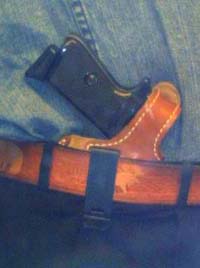 Inside The Pants Holster
The inside the pants holster is a sort of a variation of the high ride
holster. It rides in approximately the same place but, as the name implies,
the gun rides inside the user's pants rather than outside. This type of holster
conceals a bit better than the regular hip holster, but can be a bit slower
to draw from. It also subjects the gun to more perspiration from the user's
body. These can also be somewhat uncomfortable, sometimes jabbing the user
in the hip. This is also not really a suitable design for women, or for some
men who are beginning to get that middle aged roundness about the middle
(I plead guilty). I have tried this holster type, and still have some inside
the pants holsters, but it is not really a design that I care for. On top
of everything else, this type of holster essentially adds a couple of inches
to your waist, making pants and belt fit oddly. In my own case, I am constantly
finding myself arranging my pants when using this type of holster, as they
seem to always be slipping down. What might also be noticed from the photograph
is a major design flaw in this particular holster. Note the spring clip which
holds it onto the belt. This type of thing is begging for trouble, and makes
this holster very insecure. Belt clips are always a bad idea, and I do not
recommend them. There are documented examples of police officers, and suspects
pulling guns, and drawing the holster out right along with the gun. Very embarrassing,
and likely lethal. The better designs have loops and snaps to secure them
around the belt.
Inside The Pants Holster
The inside the pants holster is a sort of a variation of the high ride
holster. It rides in approximately the same place but, as the name implies,
the gun rides inside the user's pants rather than outside. This type of holster
conceals a bit better than the regular hip holster, but can be a bit slower
to draw from. It also subjects the gun to more perspiration from the user's
body. These can also be somewhat uncomfortable, sometimes jabbing the user
in the hip. This is also not really a suitable design for women, or for some
men who are beginning to get that middle aged roundness about the middle
(I plead guilty). I have tried this holster type, and still have some inside
the pants holsters, but it is not really a design that I care for. On top
of everything else, this type of holster essentially adds a couple of inches
to your waist, making pants and belt fit oddly. In my own case, I am constantly
finding myself arranging my pants when using this type of holster, as they
seem to always be slipping down. What might also be noticed from the photograph
is a major design flaw in this particular holster. Note the spring clip which
holds it onto the belt. This type of thing is begging for trouble, and makes
this holster very insecure. Belt clips are always a bad idea, and I do not
recommend them. There are documented examples of police officers, and suspects
pulling guns, and drawing the holster out right along with the gun. Very embarrassing,
and likely lethal. The better designs have loops and snaps to secure them
around the belt. |
Full Flap Holster
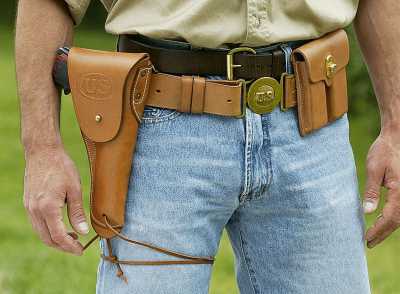 The standard flap holster is the choice for the
military, and for most sportsman who carry out in the field. This holster
offers the best security, the most protection, and the most comfort of any
design; it's one drawback (so to speak) is that it is very slow. Speed
of draw is generally not critical for sportsmen or for members of the military
(soldiers are rarely unaware that a battle is taking place, and the main weapon
of a soldier is his rifle). Though some hang down almost like drop holsters,
these holsters are generally worn fairly high, and in the center of the hip.
This makes for a good distribution of weight, and keeps the pistol out of
the way until needed. Weapon retention is so good that the wearer can run,
jump, climb, even fall, and not lose his pistol. The weapon may be drawn as
easily sitting as standing, and there is no better protection for a pistol
outside of a sealed case. Like the drop holster, the full flap requires it's
own belt, which is usually also used as a platform for the rest of the system
(magazine pouches, even cleaning kits), and other gear. This is likely the
oldest style of holster, evolving from the simple carry pouch. There is a
variation of this holster, which I call the field holster, which uses a simple
thumb break or retention strap and does not have the full flap.
The standard flap holster is the choice for the
military, and for most sportsman who carry out in the field. This holster
offers the best security, the most protection, and the most comfort of any
design; it's one drawback (so to speak) is that it is very slow. Speed
of draw is generally not critical for sportsmen or for members of the military
(soldiers are rarely unaware that a battle is taking place, and the main weapon
of a soldier is his rifle). Though some hang down almost like drop holsters,
these holsters are generally worn fairly high, and in the center of the hip.
This makes for a good distribution of weight, and keeps the pistol out of
the way until needed. Weapon retention is so good that the wearer can run,
jump, climb, even fall, and not lose his pistol. The weapon may be drawn as
easily sitting as standing, and there is no better protection for a pistol
outside of a sealed case. Like the drop holster, the full flap requires it's
own belt, which is usually also used as a platform for the rest of the system
(magazine pouches, even cleaning kits), and other gear. This is likely the
oldest style of holster, evolving from the simple carry pouch. There is a
variation of this holster, which I call the field holster, which uses a simple
thumb break or retention strap and does not have the full flap.
I own only a single full flap holster (for the
Walther P-38), and I couldn't find it when taking the photographs for this
page. The photo shown is taken from a catalog on the web. The rig shown is
the classic military pistol set which has been used by the United States
during several wars. It also has a traditional dual magazine pouch, and classic
leather pistol belt. |
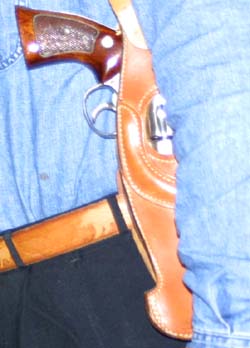 Shoulder Holster
The shoulder holster, though much glorified in movies,
and T.V. does not find much favor with me. It may just be my build (a bit
rounder than I would prefer), but this style of holster does not really
suit me. The strength of this holster type is that it is possible to carry
a large pistol, out of the way of everything, and still get a fairly fast
draw whether sitting or standing. The weapon retention of this type of holster
is fairly good, but it can "print" on the wearer, so that it can be seen
that he is armed. It is very important that this type of holster be fitted
properly, or it can be the most uncomfortable of all holster styles. Unlike
most hip holsters, the shoulder holster is worn weak side, meaning the draw
must pull the piece across the user's body. There is a cross draw option
available for hip holsters, but it is a poor choice except for conditions
under which the user is seated most of the time. Dirty Harry used a shoulder
holster in the famous movie series, and I consider this type of holster to
be the only real choice for the conditions depicted in those movies, but
most people are not as big as Clint Eastwood, nor do most armed people carry
8 3/8" barreled, large frame revolvers under a sport coat. This is the only
holster choice for very large pistols like the Thompson Contender, and is
probably the best choice for very long pistols. I only have a couple of these,
for some of my larger pistols. The unit shown is a "Dirty Harry" holster,
and is holding a S&W Model 29 44 Magnum.
Shoulder Holster
The shoulder holster, though much glorified in movies,
and T.V. does not find much favor with me. It may just be my build (a bit
rounder than I would prefer), but this style of holster does not really
suit me. The strength of this holster type is that it is possible to carry
a large pistol, out of the way of everything, and still get a fairly fast
draw whether sitting or standing. The weapon retention of this type of holster
is fairly good, but it can "print" on the wearer, so that it can be seen
that he is armed. It is very important that this type of holster be fitted
properly, or it can be the most uncomfortable of all holster styles. Unlike
most hip holsters, the shoulder holster is worn weak side, meaning the draw
must pull the piece across the user's body. There is a cross draw option
available for hip holsters, but it is a poor choice except for conditions
under which the user is seated most of the time. Dirty Harry used a shoulder
holster in the famous movie series, and I consider this type of holster to
be the only real choice for the conditions depicted in those movies, but
most people are not as big as Clint Eastwood, nor do most armed people carry
8 3/8" barreled, large frame revolvers under a sport coat. This is the only
holster choice for very large pistols like the Thompson Contender, and is
probably the best choice for very long pistols. I only have a couple of these,
for some of my larger pistols. The unit shown is a "Dirty Harry" holster,
and is holding a S&W Model 29 44 Magnum. |
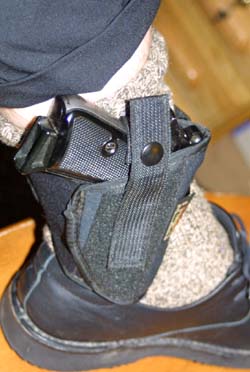
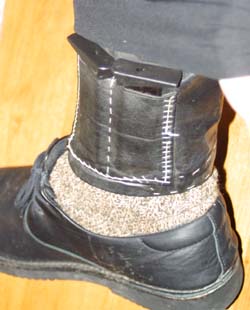 Ankle Holster
The ankle holster is suitable for for small
automatics and revolvers. I have a holster of this type for my Walther PPK. The secret of using a holster like this
is loose pants, heavy socks, and a good tight fit so that the gun does not
ride around on your ankle. The ideal positioning of the piece is canted,
with the barrel of the gun pointed down and back, behind the ankle bone.
Even with everything configured properly, this holster is very intrusive
to the wearer. I feel mine every time I take a step. The gun can not be worn
with boots, and dress socks are out of the question unless you enjoy pain.
The best way I have found to draw from this holster is to crouch ( a good
idea anyway), and raise my pant leg with one hand while drawing the pistol
with the other. I always wear this type of holster on the inside of the weak
side leg, which nestles it in the hollow of the ball of the ankle. One advantage
to this type of holster is that it is very difficult for your weapon to be
taken from you, and the best drawing positions are good defensive postures.
In any position other than a standing one, the ankle holster gives a fairly
quick draw. I have been looking around, for years, for a way to carry spare
magazines on the ankle, and have not been able to find an ankle mounted carrier
for magazines. Finally, I made one from scrap leather, and a few strips of
velcro. It works pretty well, is comfortable, and quite secure, since the
magazines do not weigh much.
Ankle Holster
The ankle holster is suitable for for small
automatics and revolvers. I have a holster of this type for my Walther PPK. The secret of using a holster like this
is loose pants, heavy socks, and a good tight fit so that the gun does not
ride around on your ankle. The ideal positioning of the piece is canted,
with the barrel of the gun pointed down and back, behind the ankle bone.
Even with everything configured properly, this holster is very intrusive
to the wearer. I feel mine every time I take a step. The gun can not be worn
with boots, and dress socks are out of the question unless you enjoy pain.
The best way I have found to draw from this holster is to crouch ( a good
idea anyway), and raise my pant leg with one hand while drawing the pistol
with the other. I always wear this type of holster on the inside of the weak
side leg, which nestles it in the hollow of the ball of the ankle. One advantage
to this type of holster is that it is very difficult for your weapon to be
taken from you, and the best drawing positions are good defensive postures.
In any position other than a standing one, the ankle holster gives a fairly
quick draw. I have been looking around, for years, for a way to carry spare
magazines on the ankle, and have not been able to find an ankle mounted carrier
for magazines. Finally, I made one from scrap leather, and a few strips of
velcro. It works pretty well, is comfortable, and quite secure, since the
magazines do not weigh much. |
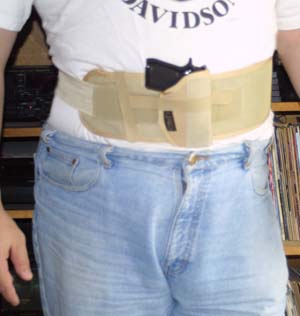 The Belly Band
The belly band holster is an excellent deep concealment
design which may be worn with any style of clothing, and can offer a fairly
quick draw with practice. Where hip and shoulder holsters require a jacket
(though some inside the pants hip holsters can be worn under a sweatshirt
or sloppy sweater), and ankle holsters require long pants of a certain style
and careful shoe and sock selection, the belly band can conceal a weapon as
long as the user is wearing a shirt.
The Belly Band
The belly band holster is an excellent deep concealment
design which may be worn with any style of clothing, and can offer a fairly
quick draw with practice. Where hip and shoulder holsters require a jacket
(though some inside the pants hip holsters can be worn under a sweatshirt
or sloppy sweater), and ankle holsters require long pants of a certain style
and careful shoe and sock selection, the belly band can conceal a weapon as
long as the user is wearing a shirt.
The belly band is something like a big surgical
or athletic bandage with a holster attached, and fasteners at the back. You
wrap it around yourself like an old style corset, being careful to orient
the gun properly. The first photo here shows the belly band put on over a
,T-shirt and the second shows it covered by a dress shirt, with a button open,
showing the draw. The big bellied user may wish to wear the gun a bit high,
while the deep chested individual may want to put it a little lower. 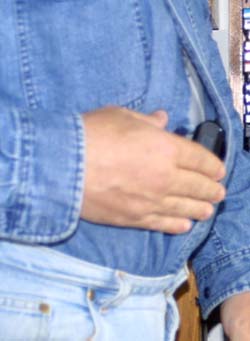 A T-shirt is required under the belly band or it will chafe, shift excessively,
and get very uncomfortable, particularly during the warmer months when this
holster would be the most useful.
A T-shirt is required under the belly band or it will chafe, shift excessively,
and get very uncomfortable, particularly during the warmer months when this
holster would be the most useful.
The best way to use this type of holster is under
a button shirt, with the button nearest, or just above the gun left open.
To draw the gun you simply slip your hand inside the shirt and withdraw the
piece. This is actually a pretty neat idea, and it will keep a gun concealed,
and fairly quick at hand, even if the user is clad in shorts and a light summer
shirt, tucked into the pants.
The biggest disadvantage is that this is suitable
for very small guns only. I use mine for my Berretta M21
(small .22), and my M1955 (very small .25). Medium
frame guns, like the Walther PPK, will fit in the holster, but they just
don't work, and print conspicuously on the user. They also weigh a
bit too much, and can slide out of the holster, if the user jumps, rolls,
or falls. I can also state from personal experience that this is a very uncomfortable
design, and can shift somewhat as the user moves. If you want to be really
slick, you can remove a button from the shirt, and sew it on over the button
hole, so that the shirt will essentially look buttoned up when it is not.
A patch of velcro can then be sewn to the inside, keeping the shirt closed,
and normal looking, while allowing very rapid access to the gun in the belly
band. |
There are a number of holster styles designed for concealed
carry. Some are variations of hip or shoulder holsters (like the semi shoulder,
or the inside the pants styles); others are specialized designs (like the
ankle or belly band). There are special holsters which permit safe carry
inside of the pocket, and even holsters that look like wallets, or pagers.
What all concealment holsters seem to have in common is poor weapon retention,
and poor protection, as well as a rather slow draw. These designs tend to
be skelitanized to the ultimate degree, and sacrifice all of the other holster
functions in preference to concealability. Weapons carried in this fashion
must be well maintained and cleaned daily, or after each wearing. My favorite,
of the concealment holsters is the ankle holster, though if I needed (and
was legally able) to carry a gun, I would most likely use a high ride hip
holster, which offers a reasonable amount of concealment, while being comfortable,
and fairly fast.
I have little experience with the other types of concealment
holsters, and many of the better ones (fanny pack, pager, and wallet types)
are in such common use that they are more likely to indicate the presence
of a gun than to conceal it. The pocket holster bears mentioning because it
is such a simple, good idea. The pocket holster is a roughly square piece
of leather with a holster sewn in. It is placed in the pocket, and when properly
fitted, keeps the gun from snagging on the clothing, and from riding around
inside of the pocket. This type of holster will also smooth the lines of the
gun so that it will not print through the pocket. This type of holster is
best used with a small revolver equipped with a hammer shroud, or a hammerless
automatic.
Though there are many types of carrying devices (holsters)
for pistols, there are essentially only two choices for rifles: the carry
strap, and the sling. What most people call a sling, is actually a carry strap,
simply a length of webbing which holds the rifle over the wearers shoulder.
An actual sling is a specialized piece of equipment used by snipers and target
shooters. A target sling will have a cuff which will fit over the shooter's
weak arm, and help to brace the rifle. A military sling will not have a cuff,
but will use a slide to accomplish the same task. A carry strap will generally
make a poor sling, but a sling can be used as a carry strap. There are carry
straps with ammunition, and even magazine holders sewn into them. Though
they seem like a good idea, I have had only fair experiences with them. The
elastic types soon become too loose to hold the cartridges, and the leather
ones are expensive, and will turn the cartridges green if they are left in
for any amount of time. I now either carry my ammunition on my belt, or in
my pockets. Loops on the carry strap look neat, but don't work very well,
and can interfere with using the strap to help steady your aim. Whether you
use a sling or a carry strap, you will need swivels to mount them on the
rifle. I prefer the quick detachable types, as the allow release of the sling
for precision shooting, and may be used to mount bipods, and other such things
to the rifle.
Charging devices
A charging device is a way to get ammunition into a
firearm. Examples of this are magazines, clips, speed loaders, etc. A semiauto
will generally use a box magazine designed for it's particular model. Revolvers,
and most rifles offer a bit more choice. There is little comment to
make on magazines; get the ones made for your model of firearm, and keep them
clean. I have at least ten magazines for each semiauto rifle I own, and ten
for every semiauto pistol. I consider this to be the minimum, and for many
of my guns I have more than this. I also have a number of extra capacity
magazines, meaning magazines that hold more than the 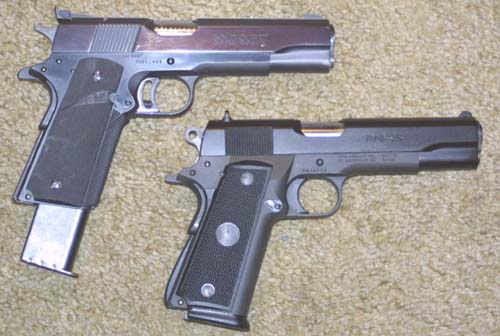 stated capacity of the gun. I have a couple of 75 round drums for my AK47, and some 30 round mags for my Ruger 10/22. I also have some extended magazines for my Glock 17, Glock 21, and
Glock 19, as well as some 10 rounders for
my Colt Gold Cup .45. There are magazine accessories
like bumpers and such, but I consider most of these things to be, at best,
for competition only. One more note, if you have a plastic magazine catch
(as in the Glock), do not buy after market, metal magazines; if you have a
metal magazine catch (most pistols, and semiauto rifles) do not buy an after
market plastic magazine. mixing materials like this will cause the plastic
part to be chewed away by the metal part, a lesson I learned the hard way.
stated capacity of the gun. I have a couple of 75 round drums for my AK47, and some 30 round mags for my Ruger 10/22. I also have some extended magazines for my Glock 17, Glock 21, and
Glock 19, as well as some 10 rounders for
my Colt Gold Cup .45. There are magazine accessories
like bumpers and such, but I consider most of these things to be, at best,
for competition only. One more note, if you have a plastic magazine catch
(as in the Glock), do not buy after market, metal magazines; if you have a
metal magazine catch (most pistols, and semiauto rifles) do not buy an after
market plastic magazine. mixing materials like this will cause the plastic
part to be chewed away by the metal part, a lesson I learned the hard way.
At one time, it was common for aftermarket companies
to offer extended magazines for pistols, and for box fed rifles. An extended
magazine is simply one which offers a larger capacity than that of the original
design, and generally sticks out of the bottom of the grip, rather than fitting
flush. This practice harkens back to the time of the First World War, when
pilots began to carry pistols. Before machine guns were designed which could
be operated from aircraft, pilots or observers would carry semi auto pistols
with ten to twenty round extended magazines. Occasionally, the expended shell
casings would cause problems with the controls or trusswork of the aircraft,
and revolvers were sometimes carried. Still, hitting a moving plane from another
moving plane was a matter of luck, and the more rounds that could be expended,
the luckier one seemed to get, giving the semi auto a clear advantage over
the revolver. An interim solution was found in the use of a cage, which fit
around the ejection port of the pistol, and was more or less, worn on the
wrist of the user.
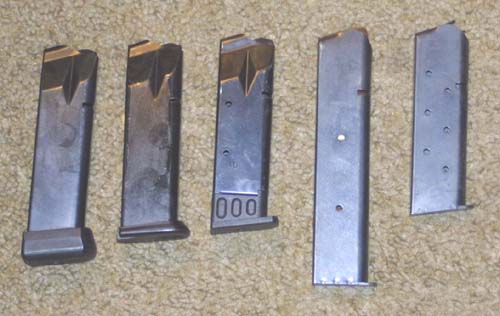 Magazines
Ten, twenty, and even twenty five, and thirty round
magazines are offered for some models of automatic pistol. Twenty and
thirty round magazines are common for military style rifles, and even the
knock around Ruger 10/22 has twenty five, and even fifty round magazines
available. This is all despite the fact that production of new magazines
which hold over ten rounds has been prohibited since September of 1994, except
for distribution to our betters in government and police work. This ban will
be ending in September of 2004, unless special steps are taken to renew it.
As of this writing (April, 2004) it seems that the ban will be allowed to
expire, though this will certainly generate the expected hysteria from the
always unreasonable members of the left. What effect this will have on prices,
production, and new firearms designs remains to be seen, though it can only
be good for the consumer. In the meantime we have new production of blocked
off magazines which are either dimpled to prevent full travel of the magazine
follower, or are cut down, and then lengthened with extra long floorplates.
I have no dimpled magazines, but the magazine in the middle of the photo
above has been shortened and then given an extra long floorplate to reduce
it's capacity from 14 rounds to the 10 round style with which civilian subjects
can be trusted..
Magazines
Ten, twenty, and even twenty five, and thirty round
magazines are offered for some models of automatic pistol. Twenty and
thirty round magazines are common for military style rifles, and even the
knock around Ruger 10/22 has twenty five, and even fifty round magazines
available. This is all despite the fact that production of new magazines
which hold over ten rounds has been prohibited since September of 1994, except
for distribution to our betters in government and police work. This ban will
be ending in September of 2004, unless special steps are taken to renew it.
As of this writing (April, 2004) it seems that the ban will be allowed to
expire, though this will certainly generate the expected hysteria from the
always unreasonable members of the left. What effect this will have on prices,
production, and new firearms designs remains to be seen, though it can only
be good for the consumer. In the meantime we have new production of blocked
off magazines which are either dimpled to prevent full travel of the magazine
follower, or are cut down, and then lengthened with extra long floorplates.
I have no dimpled magazines, but the magazine in the middle of the photo
above has been shortened and then given an extra long floorplate to reduce
it's capacity from 14 rounds to the 10 round style with which civilian subjects
can be trusted.. |
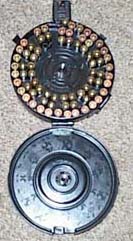 Drum and High Capacity
Various drum magazine styles are available for the Thompson
(50 and 100), the Calico (50 and 100) the Luger (32), the Colt government
(28, and 50), the AK47 (75), the AR-15 (75, 100, and 120), and the HK series
(as large as 200, with double drums). These are all very expensive, and
limited in numbers, because of the magazine ban. If the ban should expire,
which seems likely, prices will drop, and supply will increase. One of the
oddest drum magazines is a Thompson drum shell, which has been converted
into a ten round magazine. This is for cosmetic purposes only, and I can
see no reason to use a huge drum which holds only ten rounds. These ten round
drums are selling for around $200, while actual 50 rounders are selling (to
law enforcement only, of course) for about $300. For now, the pricing is
insane, though I have seen some prices drop by as much as half, in anticipation
of the expiration of the magazine ban. I can't wait to get my hands on some
of these, and see how well they work. Pricing is really in flux right now,
as there is some uncertainty over what the next year will bring. Dealers
and collectors are torn between the desire to sell off their large capacity
magazines while there is still a ban in effect to keep prices relatively
high, or to hang onto them, in case the ban should be renewed, in which case,
prices would skyrocket. Patience, patience. In the meantime, ten round compliant
magazines are as cheap as dirt. Ironically, some day the ten round mags may
be very valuable to collectors, as a dark example of silly items produced
to comply with a foolish and short lived law.
Drum and High Capacity
Various drum magazine styles are available for the Thompson
(50 and 100), the Calico (50 and 100) the Luger (32), the Colt government
(28, and 50), the AK47 (75), the AR-15 (75, 100, and 120), and the HK series
(as large as 200, with double drums). These are all very expensive, and
limited in numbers, because of the magazine ban. If the ban should expire,
which seems likely, prices will drop, and supply will increase. One of the
oddest drum magazines is a Thompson drum shell, which has been converted
into a ten round magazine. This is for cosmetic purposes only, and I can
see no reason to use a huge drum which holds only ten rounds. These ten round
drums are selling for around $200, while actual 50 rounders are selling (to
law enforcement only, of course) for about $300. For now, the pricing is
insane, though I have seen some prices drop by as much as half, in anticipation
of the expiration of the magazine ban. I can't wait to get my hands on some
of these, and see how well they work. Pricing is really in flux right now,
as there is some uncertainty over what the next year will bring. Dealers
and collectors are torn between the desire to sell off their large capacity
magazines while there is still a ban in effect to keep prices relatively
high, or to hang onto them, in case the ban should be renewed, in which case,
prices would skyrocket. Patience, patience. In the meantime, ten round compliant
magazines are as cheap as dirt. Ironically, some day the ten round mags may
be very valuable to collectors, as a dark example of silly items produced
to comply with a foolish and short lived law. |
Stripper Clips
Another charging device, generally associated with the
rifle, is the stripper clip. These were first designed for bolt action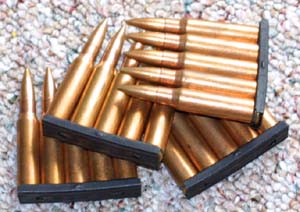 rifles, though some semiautos, and even some pistols, use them. A stripper
clip is a flat, narrow piece of metal with a lip rolled into each side.
Cartridges are slid onto it and held by their extraction grooves onto the
lip. In order to load a piece, the action is opened, and the cartridges are
slid down into the magazine. Stripper clips can be used by most bolt action
guns, and by the SKS, the M-14.
and can be used to load the box magazines of most military rifles. The newer
generation of assault rifles can not be loaded by stripper clip because a
stripper clip will only work in an action which is open all the way to the
magazine. Most military ammunition is still packaged onto stripper clips because,
even if they can not be used directly for loading the rifles, they may be
used to load the box magazines. A stripper clip will generally hold ten rounds,
though the ones shown here only hold five.
rifles, though some semiautos, and even some pistols, use them. A stripper
clip is a flat, narrow piece of metal with a lip rolled into each side.
Cartridges are slid onto it and held by their extraction grooves onto the
lip. In order to load a piece, the action is opened, and the cartridges are
slid down into the magazine. Stripper clips can be used by most bolt action
guns, and by the SKS, the M-14.
and can be used to load the box magazines of most military rifles. The newer
generation of assault rifles can not be loaded by stripper clip because a
stripper clip will only work in an action which is open all the way to the
magazine. Most military ammunition is still packaged onto stripper clips because,
even if they can not be used directly for loading the rifles, they may be
used to load the box magazines. A stripper clip will generally hold ten rounds,
though the ones shown here only hold five. |
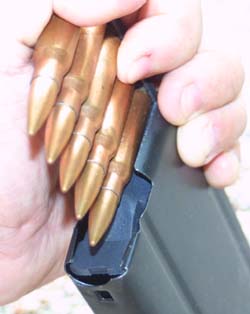
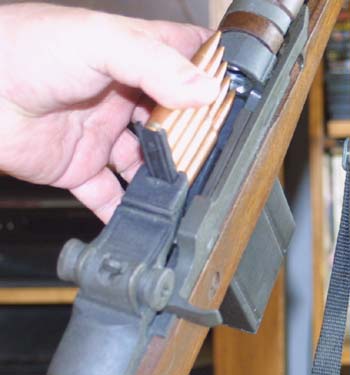 Military ammunition is generally packaged on stripper clips. They can be
used to load military box magazines by simply pushing the cartridges off
of the clip, and down into the magazine. At one time, rifles could be loaded
directly from clips, but there are few which permit this today. One of these
is the M-14/M-1A rifle. Stripper clips can be used because of the rifle's
open top design. Note the stripper clip guide, on top of the receiver, to
facilitate fast reloading with stripper clips. This was a common feature
on all battle rifles until after the Second World War.
Military ammunition is generally packaged on stripper clips. They can be
used to load military box magazines by simply pushing the cartridges off
of the clip, and down into the magazine. At one time, rifles could be loaded
directly from clips, but there are few which permit this today. One of these
is the M-14/M-1A rifle. Stripper clips can be used because of the rifle's
open top design. Note the stripper clip guide, on top of the receiver, to
facilitate fast reloading with stripper clips. This was a common feature
on all battle rifles until after the Second World War. |
There is no way to quickly load a classic lever action rifle (one of it's few faults), or a bolt
action rifle which was not designed to use stripper clips. The traditional
way of holding and dispensing ammunition for these types of guns is the cartridge
loop. cartridge loops are being sewn into belts, carrying straps, buttstock
covers, and little pouches which can slide over your belt. The best loop holders
are made out of leather; I have had, mixed experiences with the nylon and
elastic ones. The cartridge belt is also the traditional ammunition keeper
for the revolver, and is the only way to load a single action revolver,
but for the double action, swing out revolver, there are better choices.
The fastest way to load a swing out revolver is with
a device called (appropriately enough) a speed loader. A speed loader is a disc the same size as a revolver cylinder, with the requisite number
(usually six) of openings for holding cartridges. To load the piece, you
open the cylinder, eject the empties, and then line up the cartridges with
the chambers in the revolver cylinder. You then push, or twist (depending
upon the type of speed loader) to drop the cartridges into the chambers.
This can be done in little more time than it takes to load an automatic with
a magazine. Speed loaders are not universal, and the model you get must match
the revolver you are expecting to use it with. The best way to carry a speed
loader is in a (also appropriately named) speed loader pouch, which will
attach to the duty belt. Wearing a pistol belt with a revolver and several
speed loaders can be a bit awkward. If the speed loaders are worn in the
back, they dig in every time you sit down. If you wear them on the weak hand
side, you feel like the circus fat man every time you go through a doorway,
or walk through a crowded room. I have at least four speed loaders for every
revolver I own.
a disc the same size as a revolver cylinder, with the requisite number
(usually six) of openings for holding cartridges. To load the piece, you
open the cylinder, eject the empties, and then line up the cartridges with
the chambers in the revolver cylinder. You then push, or twist (depending
upon the type of speed loader) to drop the cartridges into the chambers.
This can be done in little more time than it takes to load an automatic with
a magazine. Speed loaders are not universal, and the model you get must match
the revolver you are expecting to use it with. The best way to carry a speed
loader is in a (also appropriately named) speed loader pouch, which will
attach to the duty belt. Wearing a pistol belt with a revolver and several
speed loaders can be a bit awkward. If the speed loaders are worn in the
back, they dig in every time you sit down. If you wear them on the weak hand
side, you feel like the circus fat man every time you go through a doorway,
or walk through a crowded room. I have at least four speed loaders for every
revolver I own.
There are some other ways to speed the loading of the
revolver. One way is to use a piece of leather gear called a dump pouch.
A dump pouch is a container for six cartridges with a snap. Pushing on the
snap drops the pouch and releases the cartridges which fall into the shooter's
hand. A speed strip is a flexible piece of plastic with openings for six cartridges.
There is no locking device, the cartridges are held in by friction, to be
popped out, one at a time, into the revolver chambers. A final device is
the half moon, or full moon clip. These are pieces of spring steel which are
cut to allow the insertion of .45 auto cartridges, and will only work in
the M1917 revolver. They are simply dropped into the
cylinder and the gun is loaded. I can get two loaded full moon clips into
each speed loader pouch, giving me a total of eight in the four holders on
my belt.
Target acquisition
These devices are also known as scopes, and sights,
and every gun (with the exception of some target, and long range hunting
rifles) comes out of the factory with one or another of them, but they may
be improved upon. Most duty pistols have non adjustable sights, in revolvers,
these are often milled right into the frame of the gun. Target sights tend
to be larger to give a clearer sight picture. Adjustable sights are handy
for using different types of ammunition, and for those who like to load their
own, but can be a bit delicate, and may lose adjustment. A good combat sight
will be smooth and rounded so as not to impede the draw. There are a number
of sight inserts in different colors and styles, and there are dot patterns,
and dash patterns to help the shooter line up the sights, but most agree
that a plain set of sights makes for the best sight picture. There are night
sights which have a tritium element in them and will glow for years, but
I do not care for them. The way I look at it, if it is too dark to see your
sights, sitting inches from your face, it is too dark to see your target,
and night sights won't help. I have target sights on a few of my pistols,
but none are equipped with night sights.
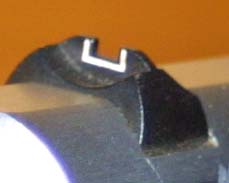 Combat sights will tend to be rounded, and low, so as not to snag on clothing.
these sights are generally fixed, as adjustable sights are a bit more delicate
and can be prone to maladjustment.
Combat sights will tend to be rounded, and low, so as not to snag on clothing.
these sights are generally fixed, as adjustable sights are a bit more delicate
and can be prone to maladjustment. |
Target sights tend to be large, squared off, and are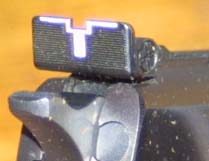 generally adjustable. This is the Colt Elliason sight as mounted on the
Gold Cup model.
generally adjustable. This is the Colt Elliason sight as mounted on the
Gold Cup model. |
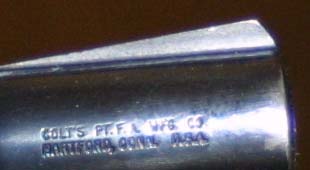 The front sight of the Colt Detective Special is pure combat. It is essentially
one large ramp, unlikely to snag on anything.
The front sight of the Colt Detective Special is pure combat. It is essentially
one large ramp, unlikely to snag on anything. |
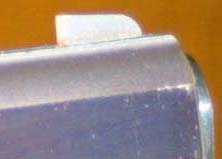 The Colt Front sight is typical target: large, square, and prone to snag.
It does give an excellent sight picture however.
The Colt Front sight is typical target: large, square, and prone to snag.
It does give an excellent sight picture however. |
Laser sights are getting to be more common, and,
in their place, I rather like them. I presently only own one laser sighted
gun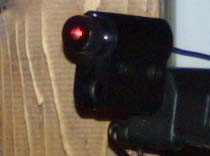 (a Calico Pistol). The laser sight is at it's
best indoors or in dim light outdoors at close range. This makes it totally
unsuitable for the rifle, but a good choice for certain pistol and shotgun
applications. The precision adjustments are similar to those on an adjustable
pistol sight. Once properly set, the laser will show a small dot at the approximate
point of bullet impact. Lasers are great for hip shooting, and are well suited
to large pistols, or small carbines. This is the ideal short range sighting
device. The laser sight has gotten very small, with the introduction of the
laser diode. They use little power, and the batteries can last months or even
years. They are also, as solid state devices, very rugged. Mine clamps on
to the end of the barrel, but there are those which fit onto the trigger guard,
and even some which fit inside of the gun, riding inside of the recoil spring,
and are actuated by a slight pressure on the trigger. At present there is
little application for this type of sight on a rifle. The exception to this
is the infrared laser sight, coupled with an infrared sensitive sniper scope
for night sniping. It is doubtful that laser sights will ever be made powerful
enough for use on rifles, or at any distance during the day. A laser of this
power would be dangerous to bystanders, as it could easily blind them. Present
laser sights are all of about 1mw, though some as powerful as 5mw are available.
(a milliwat is 1/1000 of a watt, which doesn't sound like much, but is easily
capable of causing blindness).
(a Calico Pistol). The laser sight is at it's
best indoors or in dim light outdoors at close range. This makes it totally
unsuitable for the rifle, but a good choice for certain pistol and shotgun
applications. The precision adjustments are similar to those on an adjustable
pistol sight. Once properly set, the laser will show a small dot at the approximate
point of bullet impact. Lasers are great for hip shooting, and are well suited
to large pistols, or small carbines. This is the ideal short range sighting
device. The laser sight has gotten very small, with the introduction of the
laser diode. They use little power, and the batteries can last months or even
years. They are also, as solid state devices, very rugged. Mine clamps on
to the end of the barrel, but there are those which fit onto the trigger guard,
and even some which fit inside of the gun, riding inside of the recoil spring,
and are actuated by a slight pressure on the trigger. At present there is
little application for this type of sight on a rifle. The exception to this
is the infrared laser sight, coupled with an infrared sensitive sniper scope
for night sniping. It is doubtful that laser sights will ever be made powerful
enough for use on rifles, or at any distance during the day. A laser of this
power would be dangerous to bystanders, as it could easily blind them. Present
laser sights are all of about 1mw, though some as powerful as 5mw are available.
(a milliwat is 1/1000 of a watt, which doesn't sound like much, but is easily
capable of causing blindness).
Right now, about the neatest sighting device available
is the Holosight. This is a laser generated holographic sight which is presently
available with a couple of different sighting patterns. The older model had
a dozen or so different reticles available for different holographic patterns,
including several 3D ones. I have a separate page devoted to the Holosight Model 400.
Scopes are generally associated with rifles, but they
are becoming more common on some magnum pistols, and special hunting pistols.
Pistol scopes tend to be low powered (1x to 4x), and have a long eye relief.
There is a bewildering assortment of glass for rifles, including ranging scopes,
compact scopes, and some very powerful scopes. I have scopes on all of my
rifles except for the lever actions, and three of the rifle scopes, including
one which is an actual sniper scope, have the ranging feature. There are
no scopes on any of my pistols. I go into a bit more detail on the subject,
in my page on Battlesights.
Putting it all together
The last component of a firearm system is the collection
of belts, pouches and holders, that let you carry it all. The military has
an integrated system of web gear, and most police departments have a belt
system somewhat like the old Sam Brown belt. The Sam Brown belt is a very
wide, stiff belt made from two pieces of leather sewn together. It has an
adjustable quick detach buckle, and the traditional model has a small strap
going from the belt and over the shoulder, in order to keep the belt from
shifting. If you have ever seen an old movie with police in it, you have seen
a Sam Brown belt.
Most duty belt systems are built on a wide, heavy, quick
detach belt which is designed to hold heavy gear without losing it's stiffness
( a common occurrence when a regular belt is used in a misguided attempt to
save money). Pouches, holsters, and various holders are attached to this belt,
ideally making the various components readily and speedily available. These
include things already mentioned like holsters, speed loaders or magazines
along with holders, and maybe some cleaning gear. I have seen people who do
not blink an eye at spending $700 on a pistol, put the gun in a $15 holster,
and buy a $10 web belt for it. I have done this myself, but I have learned
from it. Do not skimp on your web gear, or duty belt system, and get a good
holster made for your gun. If you own a military rifle or pistol, you have
the option of using military web gear, which is well designed, tough, and
generally cheap. This is an especially good option if you own a military rifle,
though not as good as it was before the foolish magazine ban went into effect.
Every piece of gear I own for every gun I have, including all of the magazines,
fits into a pouch somewhere on one of my belt systems. Systems for concealed
carry are a bit less elaborate, and much less versatile, but they do conceal,
and for most people who are not police officers, or armed guards, open carry
is not a legal option even in jurisdictions where concealed carry is allowed.
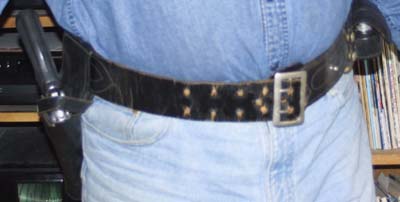 The most common Sam Brown belt is made from a double thickness of leather,
and is 2 1/4 inches wide. A dual buckle is used to help keep the weight
of the belt and accessories from canting the buckle. The traditional leather
belts are becoming less common. Many modern variations are now being made
from nylon, sewn into two layers, with a stiffening layer in between, and
a quick release buckle. Visible on the belt is a drop holster in the border
patrol style with a simple retaining strap. Also on the belt is a dual speed
loader holder.
The most common Sam Brown belt is made from a double thickness of leather,
and is 2 1/4 inches wide. A dual buckle is used to help keep the weight
of the belt and accessories from canting the buckle. The traditional leather
belts are becoming less common. Many modern variations are now being made
from nylon, sewn into two layers, with a stiffening layer in between, and
a quick release buckle. Visible on the belt is a drop holster in the border
patrol style with a simple retaining strap. Also on the belt is a dual speed
loader holder. |
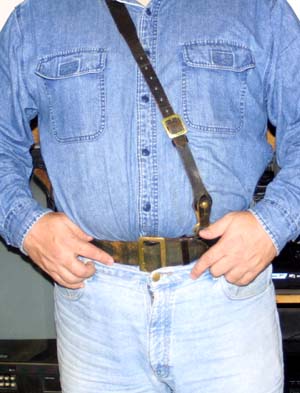
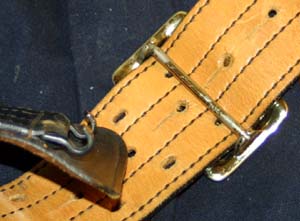 The traditional Sam Brown belt has a strap going over the shoulder. This
can bear some of the weight of accessories, but is mainly included to keep
the belt from shifting. This type of belt began to go out of style in the
seventies. It is most clearly associated with the police and military of
the thirties, through the fifties.
The traditional Sam Brown belt has a strap going over the shoulder. This
can bear some of the weight of accessories, but is mainly included to keep
the belt from shifting. This type of belt began to go out of style in the
seventies. It is most clearly associated with the police and military of
the thirties, through the fifties.
Most Sam Brown belts use quick detachable fasteners,
rather than buckles and notches. Typically these belts will hold a handgun,
spare magazines or speed loaders, radios, flashlights, batons, pepper spray,
handcuffs, and perhaps a set of gloves and a notebook. As the job of the military
and police becomes more varied and complex, ever more carriers are designed
for ever more tools. Modern military web systems use a set of suspenders to
help bear the weight of the up to seventy pounds of gear that the modern soldier
now needs to carry. |
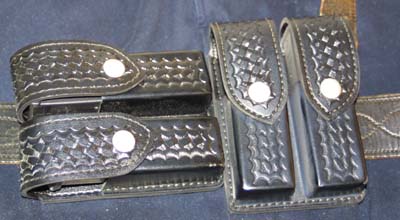
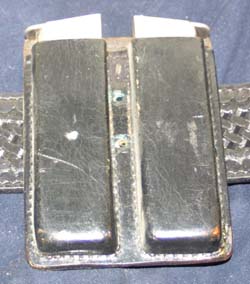 Pouches are available for all sorts of accessories, but the most common,
and useful are magazine carriers. These come in a number of styles, but
the most common are the open top, and the standard snap flap. Open top carriers
hold the magazines by friction, and are the fastest, but slightly less secure.
The classic snap flap style are sort of the magazine carrier version of the
full flap pistol holster, and offer protection and security at the expense
of speed. Some carriers give the option of being oriented either vertically
or horizontally.
Pouches are available for all sorts of accessories, but the most common,
and useful are magazine carriers. These come in a number of styles, but
the most common are the open top, and the standard snap flap. Open top carriers
hold the magazines by friction, and are the fastest, but slightly less secure.
The classic snap flap style are sort of the magazine carrier version of the
full flap pistol holster, and offer protection and security at the expense
of speed. Some carriers give the option of being oriented either vertically
or horizontally. |
|
 fast. I have holsters of this type, along with magazine pouches, for most
of my full and medium frame pistols. The model shown to the left is a standard
model, but skelitanized, for easier concealment, though most models cover
more of the gun. Notice that, as cut down as the holster is, the trigger
guard is covered. As with nearly all holsters of this type, the pistol is
secured by a thumb break strap. Those new to concealed carry, along with
some people who should know better, have taken to wearing this type of holster
further forward, sometimes even around the belly. This is somewhat unsafe,
and makes the gun less concealable, and more likely to print on the user.
It can also actually make the presentation (the draw) slower.
fast. I have holsters of this type, along with magazine pouches, for most
of my full and medium frame pistols. The model shown to the left is a standard
model, but skelitanized, for easier concealment, though most models cover
more of the gun. Notice that, as cut down as the holster is, the trigger
guard is covered. As with nearly all holsters of this type, the pistol is
secured by a thumb break strap. Those new to concealed carry, along with
some people who should know better, have taken to wearing this type of holster
further forward, sometimes even around the belly. This is somewhat unsafe,
and makes the gun less concealable, and more likely to print on the user.
It can also actually make the presentation (the draw) slower.  The standard flap holster is the choice for the
military, and for most sportsman who carry out in the field. This holster
offers the best security, the most protection, and the most comfort of any
design; it's one drawback (so to speak) is that it is very slow. Speed
of draw is generally not critical for sportsmen or for members of the military
(soldiers are rarely unaware that a battle is taking place, and the main weapon
of a soldier is his rifle). Though some hang down almost like drop holsters,
these holsters are generally worn fairly high, and in the center of the hip.
This makes for a good distribution of weight, and keeps the pistol out of
the way until needed. Weapon retention is so good that the wearer can run,
jump, climb, even fall, and not lose his pistol. The weapon may be drawn as
easily sitting as standing, and there is no better protection for a pistol
outside of a sealed case. Like the drop holster, the full flap requires it's
own belt, which is usually also used as a platform for the rest of the system
(magazine pouches, even cleaning kits), and other gear. This is likely the
oldest style of holster, evolving from the simple carry pouch. There is a
variation of this holster, which I call the field holster, which uses a simple
thumb break or retention strap and does not have the full flap.
The standard flap holster is the choice for the
military, and for most sportsman who carry out in the field. This holster
offers the best security, the most protection, and the most comfort of any
design; it's one drawback (so to speak) is that it is very slow. Speed
of draw is generally not critical for sportsmen or for members of the military
(soldiers are rarely unaware that a battle is taking place, and the main weapon
of a soldier is his rifle). Though some hang down almost like drop holsters,
these holsters are generally worn fairly high, and in the center of the hip.
This makes for a good distribution of weight, and keeps the pistol out of
the way until needed. Weapon retention is so good that the wearer can run,
jump, climb, even fall, and not lose his pistol. The weapon may be drawn as
easily sitting as standing, and there is no better protection for a pistol
outside of a sealed case. Like the drop holster, the full flap requires it's
own belt, which is usually also used as a platform for the rest of the system
(magazine pouches, even cleaning kits), and other gear. This is likely the
oldest style of holster, evolving from the simple carry pouch. There is a
variation of this holster, which I call the field holster, which uses a simple
thumb break or retention strap and does not have the full flap.  stated capacity of the gun. I have a couple of 75 round drums for my AK47, and some 30 round mags for my Ruger 10/22. I also have some extended magazines for my Glock 17, Glock 21, and
Glock 19, as well as some 10 rounders for
my Colt Gold Cup .45. There are magazine accessories
like bumpers and such, but I consider most of these things to be, at best,
for competition only. One more note, if you have a plastic magazine catch
(as in the Glock), do not buy after market, metal magazines; if you have a
metal magazine catch (most pistols, and semiauto rifles) do not buy an after
market plastic magazine. mixing materials like this will cause the plastic
part to be chewed away by the metal part, a lesson I learned the hard way.
stated capacity of the gun. I have a couple of 75 round drums for my AK47, and some 30 round mags for my Ruger 10/22. I also have some extended magazines for my Glock 17, Glock 21, and
Glock 19, as well as some 10 rounders for
my Colt Gold Cup .45. There are magazine accessories
like bumpers and such, but I consider most of these things to be, at best,
for competition only. One more note, if you have a plastic magazine catch
(as in the Glock), do not buy after market, metal magazines; if you have a
metal magazine catch (most pistols, and semiauto rifles) do not buy an after
market plastic magazine. mixing materials like this will cause the plastic
part to be chewed away by the metal part, a lesson I learned the hard way.
 Magazines
Magazines Drum and High Capacity
Drum and High Capacity a disc the same size as a revolver cylinder, with the requisite number
(usually six) of openings for holding cartridges. To load the piece, you
open the cylinder, eject the empties, and then line up the cartridges with
the chambers in the revolver cylinder. You then push, or twist (depending
upon the type of speed loader) to drop the cartridges into the chambers.
This can be done in little more time than it takes to load an automatic with
a magazine. Speed loaders are not universal, and the model you get must match
the revolver you are expecting to use it with. The best way to carry a speed
loader is in a (also appropriately named) speed loader pouch, which will
attach to the duty belt. Wearing a pistol belt with a revolver and several
speed loaders can be a bit awkward. If the speed loaders are worn in the
back, they dig in every time you sit down. If you wear them on the weak hand
side, you feel like the circus fat man every time you go through a doorway,
or walk through a crowded room. I have at least four speed loaders for every
revolver I own.
a disc the same size as a revolver cylinder, with the requisite number
(usually six) of openings for holding cartridges. To load the piece, you
open the cylinder, eject the empties, and then line up the cartridges with
the chambers in the revolver cylinder. You then push, or twist (depending
upon the type of speed loader) to drop the cartridges into the chambers.
This can be done in little more time than it takes to load an automatic with
a magazine. Speed loaders are not universal, and the model you get must match
the revolver you are expecting to use it with. The best way to carry a speed
loader is in a (also appropriately named) speed loader pouch, which will
attach to the duty belt. Wearing a pistol belt with a revolver and several
speed loaders can be a bit awkward. If the speed loaders are worn in the
back, they dig in every time you sit down. If you wear them on the weak hand
side, you feel like the circus fat man every time you go through a doorway,
or walk through a crowded room. I have at least four speed loaders for every
revolver I own.
(a Calico Pistol). The laser sight is at it's
best indoors or in dim light outdoors at close range. This makes it totally
unsuitable for the rifle, but a good choice for certain pistol and shotgun
applications. The precision adjustments are similar to those on an adjustable
pistol sight. Once properly set, the laser will show a small dot at the approximate
point of bullet impact. Lasers are great for hip shooting, and are well suited
to large pistols, or small carbines. This is the ideal short range sighting
device. The laser sight has gotten very small, with the introduction of the
laser diode. They use little power, and the batteries can last months or even
years. They are also, as solid state devices, very rugged. Mine clamps on
to the end of the barrel, but there are those which fit onto the trigger guard,
and even some which fit inside of the gun, riding inside of the recoil spring,
and are actuated by a slight pressure on the trigger. At present there is
little application for this type of sight on a rifle. The exception to this
is the infrared laser sight, coupled with an infrared sensitive sniper scope
for night sniping. It is doubtful that laser sights will ever be made powerful
enough for use on rifles, or at any distance during the day. A laser of this
power would be dangerous to bystanders, as it could easily blind them. Present
laser sights are all of about 1mw, though some as powerful as 5mw are available.
(a milliwat is 1/1000 of a watt, which doesn't sound like much, but is easily
capable of causing blindness).